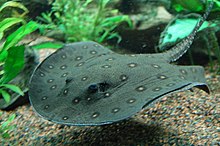Ocellate river stingray
| Ocellate river stingray | |
|---|---|
 |
|
 |
|
| Scientific classification | |
| Kingdom: | Animalia |
| Phylum: | Chordata |
| Class: | Chondrichthyes |
| Subclass: | Elasmobranchii |
| Order: | Myliobatiformes |
| Family: | Potamotrygonidae |
| Genus: | Potamotrygon |
| Species: | P. motoro |
| Binomial name | |
|
Potamotrygon motoro (J. P. Müller & Henle, 1841) |
|
The ocellate river stingray (Potamotrygon motoro), also known as the peacock-eye stingray, is a species of freshwater stingray in the family Potamotrygonidae. It was the first species to be described in the family and is also the most widespread, ranging throughout much of the Río de la Plata, Amazon, Mearim and Orinoco basins in tropical and subtropical South America. It is sometimes kept in aquaria.
P. motoro varies significantly in appearance and morphology over its large range, and a taxonomic review of the Amazonian populations is expected. The taxonomy of the populations in the Río de la Plata Basin was reviewed in 2013, leading to the finding that P. motoro is found virtually throughout (absent from the Paraná Basin upriver from Itaipu Dam), but also that there are two additional members of this species complex: P. amandae (widespread in Río de la Plata Basin) and P. pantanensis (northern Pantanal). Currently recognized members of the species complex found elsewhere are P. boesemani (Corantijn River; P. motoro absent),P. jabuti (mid and upper Tapajós Basin; P. motoro in the lower), and P. ocellata (lower Amazon Basin), but the last may be a synonym of P. motoro.
P. motoro can grow up to 50 cm (1.6 ft) in disc width, 1 m (3.3 ft) in total length, and 35 kg (77 lb) in weight. Its disk is roughly circular in shape, and its eyes are raised from the dorsal surface. The dorsal coloration is typically beige or brown, with numerous light orange spots with dark rings. Its exact color, and the arrangement and size of the spots can vary significantly, both from individual to individual and depending on location. For example, individuals from Orinoco and Rio Negro (which are connected by the Casiquiare canal) are similar, but differ from individuals elsewhere.
...
Wikipedia

